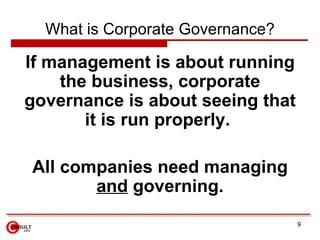Corporate Governance
- 1. Corporate Governance Why and What Anand Subramaniam
- 2. “There has been in recent years excessive emphasis on a citizen's rights and inadequate stress put upon his duties and responsibilities.” - Paxton Blair 2
- 3. Highlights Corporate Governance – Overview Corporate Governance – Pillars Corporate Governance - Elements 3
- 4. Corporate Governance - Overview
- 5. Why Corporate Governance? Better access to external finance Lower costs of capital – interest rates on loans Improved company performance – sustainability Higher firm valuation and share performance Reduced risk of corporate crisis and scandals 5
- 6. Corporate Governance - Parties Share- Manager Directors holders Who use the Guardians of Company’s Those that own the Company’s assets the company assets for the Shareholders 6
- 7. Corporate Governance vs. Management Accountability Accountability and and Corporate Supervision Corporate Supervision Governance Governance Strategic Strategic Management Management Executive Mgmt. Corporate Executive Mgmt. Corporate -Decision and Control- Management - Decision and Control - Management Operational Mgmt. Operational Mgmt. Source: Robert Tricker,Corporate Governance, 1984 Source: Robert I. Tricker, Corporate Governance, 1984 7
- 8. Corporate Governance is NOT.. Corporate governance ≠ corporate / financial management Corporate governance ≠ corporate social responsibility or business ethics 8
- 9. What is Corporate Governance? If management is about running the business, corporate governance is about seeing that it is run properly. All companies need managing and governing. 9
- 10. Corporate Governance - Pillars
- 11. Accountability Fairness Transparency Corporate Governance - Pillars Independence 11
- 12. Accountability Ensure that management is accountable to the Board Ensure that the Board is accountable to shareholders 12
- 13. Fairness Protect Shareholders rights Treat all shareholders including minorities, equitably Provide effective redress for violations 13
- 14. Transparency Ensure timely, accurate disclosure on all material matters, including the financial situation, performance, ownership and corporate governance 14
- 15. Independence Procedures and structures are in place so as to minimise, or avoid completely conflicts of interest Independent Directors and Advisers i.e. free from the influence of others 15
- 16. Corporate Governance - Elements
- 17. Corporate Governance - Elements Well- Good defined Board share- practices holder rights Control Board Environ- Elements commit- ment ment Trans- parent P/E Ratio disclo- sure 17
- 18. Good Board Practices Clearly defined roles and authorities Duties and responsibilities of Directors understood Board is well structured Appropriate composition and mix of skills Appropriate Board procedures Director Remuneration in line with best practice Board self-evaluation and training conducted 18
- 19. Control Environment Internal control procedures Independent audit committee established Risk management framework present Internal Audit Function Disaster recovery systems in Management Information place systems established Media management Compliance Function techniques in use established Business continuity Independent external auditor procedures in place conducts audit 19
- 20. Transparent Disclosure Financial Information disclosed Non-Financial Information disclosed Financials prepared according to International Financial Reporting Standards (IFRS) Companies Registry filings up to date High-Quality annual report published Web-based disclosure 20
- 21. Well-Defined Shareholder Rights Minority shareholder rights formalised Well-organised shareholder meetings conducted Policy on related party transactions Policy on extraordinary transactions Clearly defined and explicit dividend policy 21
- 22. Board Commitment The Board discusses corporate governance issues and has created a corporate governance committee The company has a corporate governance champion A corporate governance improvement plan has been created Appropriate resources are committed to corporate governance initiatives Policies and procedures have been formalised and distributed to relevant staff A corporate governance code has been developed A code of ethics has been developed The company is recognised as a corporate governance leader 22
- 23. “When a man says he approves of something in principle, it means he hasn't the slightest intention of carrying it out in practice.” - Otto von Bismarck 23























